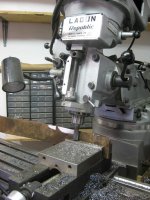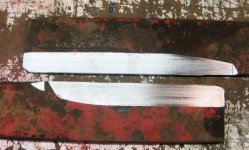I do have rocks. Up to potato size pieces of flint and my blades end up looking like hammered dog crap. That being said, it would be a total government project (free labor and machine time).
I feel your pain. I've been out 'hoggin' for the last few days, chopping down the grasses and weeds on about 8 acres of hillside. Lots of buried stumps and rocks that I just can't see under the tall grass, and the first thing I hear about it is the ruckus under the mower deck. Stump jumpers can only do so much, and today I hit a stump so hard it oil canned the deck so the blade mount was rubbing:

A few minutes with a 4' pry bar got things more or less back into shape, but while I was under there I took a few shots of the blades themselves:

I bought the 'hog used, and I thought the blades were bad then. I straightened them out with a mill, but since I'd never used a brush hog before on rough ground, I really had no idea of what I was getting into:


I think I'd really have to think hard about spending a lot of time on fancy, time consuming machining, welding/brazing, and heat treating in light of what's GOING to happen first time you hit a rock (when, not if). I'd also plan for the worst, and hope for the best. That is to say I wouldn't try anything that could even remotely result in a chunk of metal breaking off the blade and exiting through the side of the mower deck. It's bad enough when chunks of wood and stone get shot out by the blades, but metal is a lot more dense, will travel farther, and have more energy at the end of its trajectory. For that reason I'd maybe start looking at some sort of hard facing operation that would build up the edge maybe ten or fifteen thousandths, leaving the ductile material of the original blade just below the surface to keep things together when it hits something hard. Grind that back to a nice high angle edge and you might get a better cut and not cry so much when you have to do it over first time the inevitable happens.




